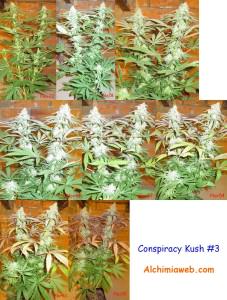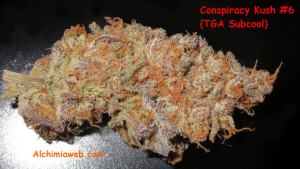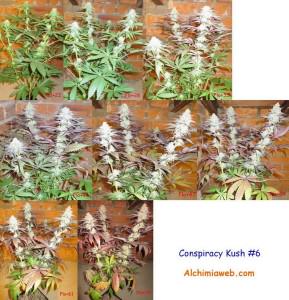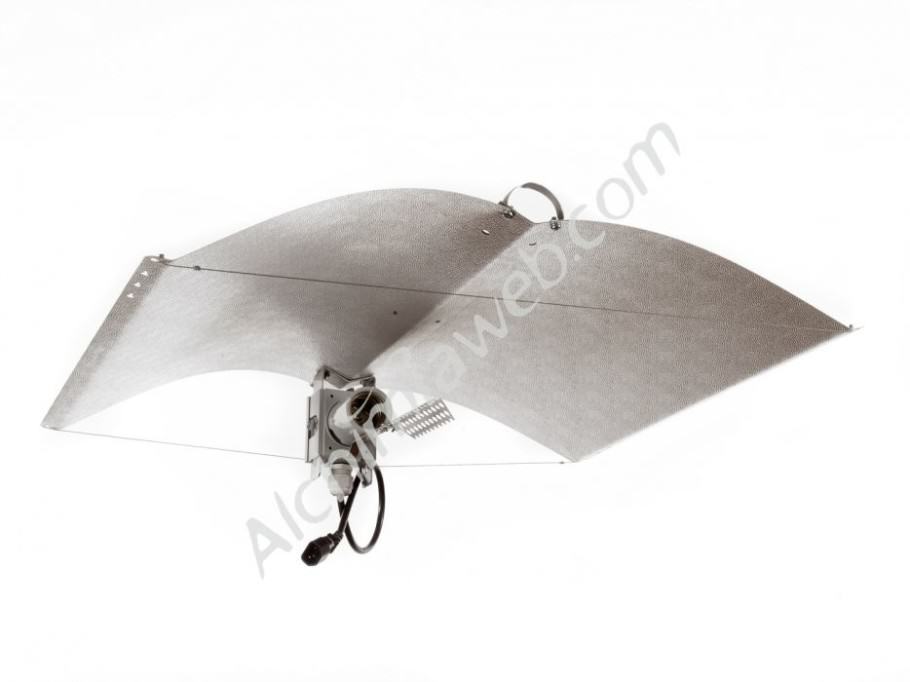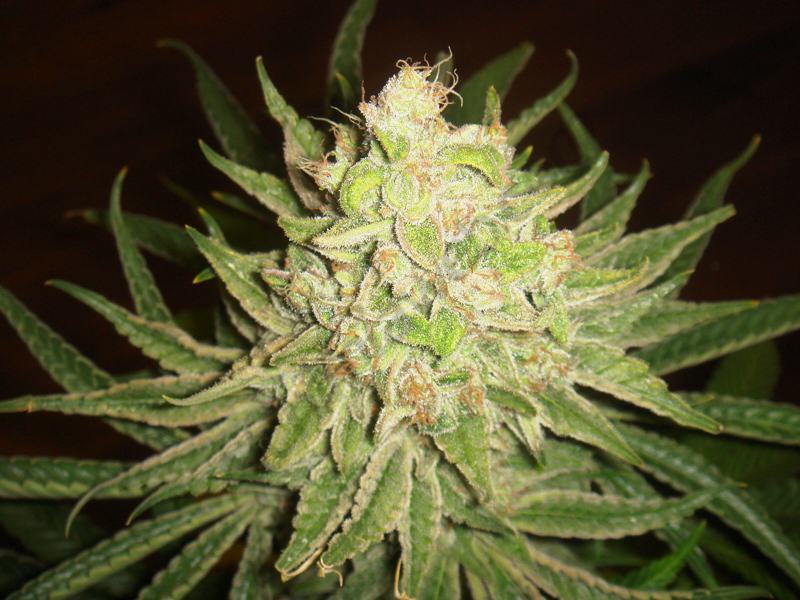Growing regular cannabis seeds indoors
List of contents
- Growing regular marijuana seeds is easy
- Equipment for the crop, nutrients and marijuana strains
- Germination of cannabis seeds
- Growth of cannabis plants
- Pre-flowering of cannabis plants (weeks 1 and 2 of flowering)
- Cannabis plants in full bloom (3rd and 4th weeks)
- Peak of flowering (5th and 6th weeks)
- Flushing the roots of cannabis plants (7th and 8th weeks)
- End of flushing and harvest (9th and 10th weeks)
- Drying and curing cannabis buds
- Smoke report of Conspiracy Kush and 818 Headband
Growing regular marijuana seeds is easy
Contrary to popular belief, growing regular marijuana seeds (in which we find male and female plants) isn?t more difficult than growing feminized seeds. They are accessible for everyone, also for beginners. Until early 2000, everybody learned to grow marijuana using regular seeds and the selection of female and male plants was just another step of the grow, something fast and simple to realize, such as the germination process or switching the photoperiod.

Naturally, 50% of the regular seeds are males and the other 50% are female plants. Of course, several factors can alter this ratio, but if using more than 10 seeds it's almost impossible not getting a single female plant (the chances of getting 10 males out of 10 seeds is lower than 1:1000). Some people think that environmental conditions might influence on this male / female ratio (good conditions usually bring more females), but this theory hasn't been verified in a rigorous way yet.
So, generally we recommend you to germinate 15 or 16 regular marijuana seeds for every square meter in small flowerpots. Grow them for few weeks and then switch to bloom, right before removing the males and transplanting the female marijuana plants into the definitive containers. Normally, we use 6-10 plants per square meter during the flowering stage.
In this article we will show you a grow report of 16 regular seeds using a 90 x 90 cm (or 81 m2) grow tent. The crop took around 3 months (from early October until late December). We gave our plants a growth period of 3 weeks and, approximately, 10 weeks of flowering.
Equipment for the crop, nutrients and marijuana strains
This indoor crop was performed in a DarkRoom V2 90 grow tent, with a 400W HPS bulb for the flowering phase. We used organic nutritients from the following brands: Aptus, General Organics, BAC and Cannabiogen:
- Growth Fertiliser: Bio Thrive Grow (General Organics)
- Bloom Fertiliser: Organic PK Booster (BAC)
- Growth Stimulator: Start Booster (Aptus)
- Bloom Stimulator: Top Booster (Aptus)
- Regulator (Aptus)
- Delta 9 (Cannabiogen)

The beneficial fungus Trichoderma Harzianum, which grows in symbiosis with the roots of the marijuana plant, was used in each watering throughout the crop. We would like to stress the importance of using Trichoderma from seedling and also after each transplant. Trichoderma allows you to protect the roots from attacks of fungal pathogens and improve the nutrient uptake by the roots.
The Organic PK Booster from BAC contains P&K (Phosphorus and Potassium), as well as Nitrogen (N) and all the essential micronutrients needed by the plants, so it?s possible to use it as complete organic flowering fertiliser for your marijuana plants. It also contains sugars (molasses) and other interesting natural ingredients.
We used Light Mix with a bit of Bio Super Mix to enrich the soil composition. The chosen cannabis strains to grow were:
- 8 regular seeds of Conspiracy Kush from TGA Subcool, a mostly Indica cross between Obama Kush and Space Queen.
- 8 regular seeds of 818 Headband from The Cali Connection, a hybrid of Sour Diesel and OG Kush, two famous genetics from USA.
Germination of cannabis seeds
16 marijuana seeds were set to germinate between two dishes, using paper towels moisturized with water and Trichoderma.

You should make use of the microbial life as soon as possible so that the symbiosis will be effective from the beginning and the small radicle is protected against the attacks of fungi and diseases such as the Phytium or wilting. Normally, it will be possible to observe the development of the Trichodermas on the roots.
Keeping the temperature between 20 and 25° C, 100% of the seeds sprouted within 48 hours. They were planted into 3 litre pots during approximately 3 weeks of growth. It?s possible to use smaller plant pots during the first days of the plant's life to create a more dense and effective root system.

Growth of cannabis plants
From the beginning of the growth period we could observe traces of thrips in the youngest leaves, noticing the silver dots typical of this pest. We soon used a treatment using biological insecticides, spraying the plants with this mixture:
- Azaprot (Neem Oil) 2 ml/L
- Pireprot (Crisanthenum Pyrethrum Extracts) 2 ml/L
- Cinnaprot (Cinnamon extract) 2 ml/L
- Alliumprot (Garlic slurry) 6 ml/L
If you want, you can replace the Azaprot, Pireprot and Cinnaprot from Ecoprotec for Trabe's Ain THC, Expelex and Bio Fungi C Grow.

Generally, when using natural insecticides, we recommend mixing different active ingredients to prevent insects, diseases or mites, thus improving the plant resistance from the start. This mixture allows you to fight with natural methods against a great diversity of insects and mites, using it either as preventive or to erradicate pests.

During the second week of growth, we stimulate the vigour of the plants spraying 5 ml/L of Delta 9 from Cannabiogen, a product rich in vitamins, amino acids and nutrients. After around 15 days since the beginning of the plants life, we start adding growth fertiliser (Bio Thrive) to the nutrient solution, gradually increasing the dose while looking for nutrient excesses.

During the last week of growth (3rd week), we apply another insecticide treatment before switching to bloom. At this point, we prune the tops of the plants to keep their vertical growth under control, what will also be beneficial for the development of side branches.

During this growth period, the temperature varied between 22 and 31 ° C, while the humidity level was between 40 and 70%. At early Autumn the weather can be really hot in Spain, and the humidity level raised as the plants grew.
Pre-flowering of cannabis plants (weeks 1 and 2 of flowering)
The growing space was full and it was time to switch our plants into the flowering phase, reducing the growth photoperiod - 18 hours of light per day (18/6) - to 12 hours of light per day (12/12).
We divide the flowering stage in three consecutive phases, and each phase must be performed perfectly to ensure a good harvest. These phases are: the stretch, the bud development and the final ripening of the plants, the last stage before the harvest of marijuana plants.
When we switch to 12/12, the stretch period begins and plants grow notably until reaching their final height, a phenomenon comparable to the adolescence of humans. During this period, cropping the branches of the higher plants - trying to keep them as uniform in height as possible- is advised.

While marijuana plants are normally very vigorous and very resistant during the flowering period, this is a crucial moment for them and the grower should take care of their needs properly: if you don't look after your plants during this stage, you will take the risk of creating a jungle very difficult to control once in full bloom, especially when working with different genetics.
The watering and feeding needs (especially Nitrogen) must be accurately met during the stretch of plants, so we must pay close attention to prevent any drought or deficiency which would slow down the overall plant development. During the transition to flowering, we used again Delta 9 from Cannabiogen (via foliar), to help and stimulate the plant metabolism during this important stage.

Few days after switching to 12/12, we could already identify the female plants for the two pistils (white hairs) that develop on the internodes of the branches, so we could easily identify and remove the male plants, which develop very different flowers, shaped like small clusters or sacks.
In this crop, we got the following number of males and females:
- Conspiracy Kush: 7 female plants, 1 male plant
- 818 Headband: 3 female plants, 5 male plants
Thus, we had 10 female plants to flower, which were quickly transplanted into 7 litre pots. We pruned the lower parts of the plants to favour the top parts, which are more exposed to the light. These small branches were rooted as cuttings in a small propagator (during the growth cycle, 18/6), so we could keep an exact copy of each grown female.
After the harvest, the tasting will allow us to choose the best female according to our criteria (taste, smell, effect, yield, resin production, resistance to pests, etc.) and keep them as mother plants, so we can grow the same plant again and always with the same traits. Indeed, regular seeds are the perfect option for selecting mother plants.

Right after the end of the stretch, all plants were treated for the last time with a biological insecticide. If you want to make your own regular seeds, you can also select and keep the best males in a separate space. If you don't want to make seeds, then you should remove them as soon as you identify them to avoid that they release their pollen and get your plants seeded.
During the stretch the temperature ranged from 21ºC to 28ºC and the humidity level was between 40% and 60%.
Cannabis plants in full bloom (3rd and 4th weeks)
As soon as we see that our plants are starting to develop buds we can stop using growth fertiliser and root stimulators, which will be replaced for nutrients and boosters formulated for the flowering stage.

A third and last application of Delta 9 will stimulate the metabolism of the plants for the next weeks. The stretch phase has finished, except for one 818 Headband from The Cali Connection plant that keeps on growing. We continue cropping it regularly and place it on a corner of the growing space.
The flowering was slowed down due to low temperatures, so we added heat cables around the pots: the roots of cannabis plants are sensitive to cold and we must warm them if necessary. Just like us, marijuana doesn?t like cold feet. We decrease the potency of the extraction fan with the help of a power controller to keep the heat produced by the lamp in the growing space.
After these changes, the temperature ranged from 12 °C (light off) to 20 °C (light on) and humidity ranged between 50% and 70%.

At this stage of bloom the buds are beginning to develop a considerable amount of resin, and the smell is more and more intense, so using carbon filters is advised if you want a discreet crop.
Peak of flowering (5th and 6th weeks)
At this moment, the Conspiracy Kush plants from TGA develop beautiful bluish colors favoured by the low temperatures during the night periods. We keep on using our feeding schedule and any plant shows symptoms of deficiencies during this stage, in which the buds fatten up day by day.

Once into flowering, marijuana plants need very little maintenance, but we should look with diligence for the presence of insects, mites, fungi, deficiencies and excesses or hermaphrodite plants.
At this point, the temperature ranged from 14 to 25° C and the humidity from 50 to 70%. In some Conspiracy Kush phenotypes the resin production was excellent, as well as the superb scents released by the more resinous plants.

Flushing the roots of cannabis plants (7th and 8th weeks)
The dosages of the nutrients and boosters used have been progressively reduced so that washing the roots of the plants is performed more progressively and effectively. The plants will now use the nutrient reserves they've kept in their tissues, principally in the leaves but also in other parts of the plant. Flushing the roots highly improves all the aspects of the final product, improving both the organoleptic features and its medicinal properties.

At this stage, the buds stop growing; the plants start their ripening process, the last stage of the flowering period; the flowers develop more and more terpenes and trichomes. During this period, the temperature ranged between 14 and 25 °C with a humidity level from 50 to 70 %.

End of flushing and harvest (9th and 10th weeks)
During the end of the flowering satge, when plants come to the end of their life cycle, we will use only water - without fertilisers - to perform a more rigorous root flushing. The chlorophyll breaks down and the plants lose their green colour: if carotenoids predominate, the plant will turn into yellow colors, but if the anthocyanins dominate - a natural pigment present in blue varieties which appears due to low temperatures as a protection from the cold) the marijuana plants will turn into a beautiful purple/bluish colour.

During this period it?s also important to be patient and to observe the resin glands on the buds, waiting for the ideal moment to harvest our plants. Normally, we will harvest them when most the resin glands are white/milky and only few amber trichomes are present, a sign that THC is starting to degrade into CBN, a cannabinoid which has only 10% of the psychoactive effect of THC.
The temperature ranged from 14 to 25 °C and the humidity from 50 to 70 %. The smell of the plants is amazing, constantly producing the aromatic terpenes typical of cannabis plants.

Drying and curing cannabis buds
During the harvest, each plant was carefully examined looking for molds. Fortunately, and despite having a relative humidity rather high during the bloom phase, any plant was attacked by fungi. A good ventilation, and the regular use of Trichoderma during the growth stage greatly helped to avoid the risk of mold on the buds, which often start growing in the substrate.
We discovered few male flowers in one of the 818 Headband plants, but they certainly were sterile because we never found any seeded bud.
The drying process was performed in a dark place, with a constant temperature of approximately 15 °C and during 4 weeks. A long drying process demands more patience, but surely rewards the grower with superior organoleptic quality.

The small leaves of the buds, completely covered with resin glands, were trimmed after drying and kept to make high grade homemade hashish. The buds were stored in glass jars and opened every day for 30 minutes during around 3 weeks, until being properly cured; this crucial final stage is called curing.
The grower estimated a yield of 25-30 grams per plant, a total of 250-300 grams.
Smoke report of Conspiracy Kush and 818 Headband
If speaking about the cultivation of these strains, we liked the Conspiracy Kush better than the 818 Headband, mainly due to its beautiful purple colours and impressive production of resin glands, a characteristic trait of all TGA Subcool strains. These are easy to grow genetics, with a relative stability between females, what suggests a great predominance of the mother Obama Kush in this hybrid. The 818 Headband is more vigorous, especially during the stretch stage, developing more side branches and yielding a bit more.
Smoke report of Conspiracy Kush from TGA Subcool:
- Appearance: Great bag appeal, compact buds with a nice layer of resin and beautiful green/purple colours. The small leaves of the buds are covered with resin and produce excellent hashish. Score: 5/5
- Flavour: Conspiracy Kush produces a very soft smoke when inhaling. We will notice hashy and fruity notes - reminiscent of grapes and berries - with lemony undertones. The fruity and sweet flavour increase as the curing process advances. We will see some differences from one female plant to another, but they all have very similar taste. Score: 4/5
- Effect: The effect is mainly body relaxing, typical of Indica marijuana strains, although it isn?t a couch-locking high. This variety is perfect to fight against stress, insomnia or to relax after a hard day of work. Score: 4/5
Smoke report of 818 Headband (Sour Diesel x OG Kush) from The Cali Connection
- Appearance: 818 Headband buds compact, but not as Conspiracy Kush'. The flowers are light coloured and resin production is above average. Score: 4/5
- Flavour: Sour Diesel notes mixed with earthy undertones inherited from the OG Kush. The smoke is harsher than Conspiracy Kush, less refined in respect of aromas. Score: 3/5
- Effect: The 818 Headband produces a powerful and balanced effect between high and stoned, starting with a relatively strong cerebral effect that quickly becomes a more relaxing experience. Thus, it is a good choice for those who are seeking a balanced effect, suitable for the day but also before going to sleep, for medicinal purposes or simply to enjoy the plant recreationally. Score: 4/5










